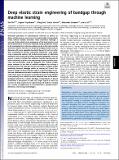Deep elastic strain engineering of bandgap through machine learning
Author(s)
Shi, Zhe; Dao, Ming; Li, Ju
DownloadPublished version (1.138Mb)
Publisher Policy
Publisher Policy
Article is made available in accordance with the publisher's policy and may be subject to US copyright law. Please refer to the publisher's site for terms of use.
Terms of use
Metadata
Show full item recordAbstract
Nanoscale specimens of semiconductor materials as diverse as silicon and diamond are now known to be deformable to large elastic strains without inelastic relaxation. These discoveries harbinger a new age of deep elastic strain engineering of the band structure and device performance of electronic materials. Many possibilities remain to be investigated as to what pure silicon can do as the most versatile electronic material and what an ultrawide bandgap material such as diamond, with many appealing functional figures of merit, can offer after overcoming its present commercial immaturity. Deep elastic strain engineering explores full six-dimensional space of admissible nonlinear elastic strain and its effects on physical properties. Here we present a general method that combines machine learning and ab initio calculations to guide strain engineering whereby material properties and performance could be designed. This method invokes recent advances in the field of artificial intelligence by utilizing a limited amount of ab initio data for the training of a surrogate model, predicting electronic bandgap within an accuracy of 8 meV. Our model is capable of discovering the indirect-to-direct bandgap transition and semiconductor-to-metal transition in silicon by scanning the entire strain space. It is also able to identify the most energy-efficient strain pathways that would transform diamond from an ultrawide-bandgap material to a smaller-bandgap semiconductor. A broad framework is presented to tailor any target figure of merit by recourse to deep elastic strain engineering and machine learning for a variety of applications in microelectronics, optoelectronics, photonics, and energy technologies.
Date issued
2019-02-15Department
Massachusetts Institute of Technology. Department of Materials Science and Engineering; Massachusetts Institute of Technology. Department of Nuclear Science and EngineeringJournal
Proceedings of the National Academy of Sciences of the United States of America
Publisher
Proceedings of the National Academy of Sciences
Citation
Shi, Zhe et al. "Deep elastic strain engineering of bandgap through machine learning." Proceedings of the National Academy of Sciences of the United States of America 116 (2019): 4117-4126 © 2019 The Author(s)
Version: Final published version
ISSN
0027-8424
1091-6490
Keywords
Multidisciplinary